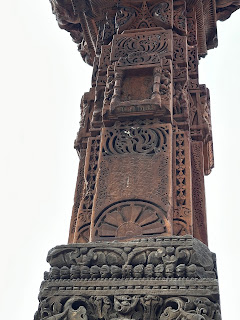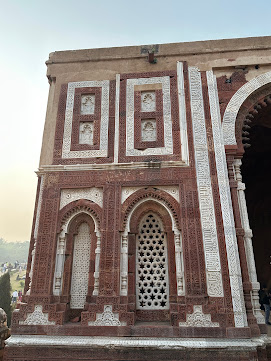December 22, 2025
I admit that I am obsessed with the traffic in India. Here's yet another post beginning with traffic footage. This one shows us trying to cross the street on foot. DO NOT ATTEMPT THIS ON YOUR OWN. You should be with a guide who can, well, guide you across.
Pay attention to the signage, which is often good for a laugh or at least a smile.
And watch out for the traffic cops. Some don't look so friendly. And the trees have eyes (eyeglasses?)!
No, it is not a disease, but it is place full of names of people I have never heard of and can't pronounce. I will try to keep it simple. The buildings are from the Delhi Sultanate, a medieval empire that stretched across India for about 300 years.
The mosque consists of a rectuangular coutyard enclosed by covered pathways, what Christians would call "cloisters." Walking among the pillars, it was easy to see that there were many different styles. Some had to be plastered over because images were prohibited in mosques, but the plaster has long disintegrated and revealed the original designs.
This circular stone ceiling is incomprehensible to me.
A wide range skill level is apparent in the details of the columns, and their ages must vary widely as well.


Another structure in the complex is the Ala'i Darwaza Gate, built when Qutb-ud-din Aibak's son expanded the mosque in 1211-1236. Decorated with intricate carvings in red sandstone and marble, it is the magnificent square-domed building seen at the left of the photo below.
Another mind-boggling interior dome made of red sandstone:
Paintings on the underside of the arches (left) and a beautiful carved stone window (right):
More carved marble and sandstone and more green parrots:
Imagine wandering through this place at night with only a candle or even a flashlight. Terrifying!
A wide range skill level is apparent in the details of the columns, and their ages must vary widely as well.
Now THERE are some ancient, er, columns!
What dominates the mosque and makes the complex famous is the Qutb Minar Victory Tower, which celebrates the Muslim conquest of India. It was mostly built between 1199 and 1220 but not completely finished until 1368. The tower contains 399 steps and is 238 feet tall. As a point of comparison, the Leaning Tower of Pisa is only 183 feet tall. AMAZING.
Judging by the many types of blocks and the variety of colors, the gate also appears to be constructured from materials pilfered from destroyed Jain and Hindu temples. They provide a nice backdrop for the colorful parrots we saw at the site.


As when visiting the Eiffel Tower, every tourist needs their moment of glory with the Qutb Minar Victory Tower. And by the way, the angle makes it look like it is leaning, but it is not.
Yet again, we found ourselves wondering why we had never heard of this magnificent place.
Verses from the Qur'an are carved into the bands that encircle the tower.
One curiosity in the complex is this iron pillar, which was created in about 400 or 500 AD and moved to this location in the 9th century. Hindu in origin, it is the only thing left from the structure that preceded the mosque on this site. In fact, the mosque was constructed around it, and it may have inspired the Victory Tower. The pillar is almost 24 feet tall and weighs over 7 tons. Also, although it is made of iron, it has not rusted in over 1500 years!
Another structure in the complex is the Ala'i Darwaza Gate, built when Qutb-ud-din Aibak's son expanded the mosque in 1211-1236. Decorated with intricate carvings in red sandstone and marble, it is the magnificent square-domed building seen at the left of the photo below.
Left: The little square building with a round dome and white columns is the 16th-century Tomb of Mohamad Ali (no, not the boxer), also known as Imam Zamin, a Muslim leader who actually built the tomb himself during the reign of Humayan. (See previous post for more on Humayan.) It is unrelated to the other structures in the complex.
Right: After the mosque had been doubled in size by additions, one of the later rulers began building a tower called the Alai Minar. The tower was supposed to be twice as high as the Qutb Minar in proportion to the enlarged mosque. However, only the first 82 feet (about 1/4 of Qutb Minar) were built before that ruler's death, and no one else ever took up the job. Today it looks like a pile of rubble.
What a cute old couple. Why do they keep photobombing my pictures?
It had been a long day, and somehow everything feels more intense in a city like Delhi. It has to do with the sensory overload you feel there--more noise, more smells, more colors, more motion, more everything. We were ready for some quiet time in a dimly-lit restaurant in our five-star hotel.
Dinner was in the Spice Route Restaurant in the hotel. Our travel company had told Bob that it is one of the best restaurants in India. It was beautifully decorated, and the food was good but by no means spectacular. Bob had duck leg and I had lamb shank, both average.
However, I don't think we'll ever forget our stay at The Imperial. What made it especially memorable is what happened the next day. Chris's first words to be at breakfast were, "I've had a very exciting morning!" She had somehow gotten locked in the smaller of the two bathrooms in her suite and couldn't get out. She couldn't unlock the lock, Stan couldn't, and hotel maintenance couldn't. Hotel maintenance had to resort to hacking through the door with an axe to get her out, a process that took 45 minutes. Luckily, Chris was fully dressed. Sadly, she didn't have her phone and had nothing to do while she waited. The damage they did to her door was pretty substantial.Amazingly, they had completely replaced the door and repaired other damage by the time we got back at the end of the day! That's service!






















































I'm glad you are researching this history and posting on it. I struggle with U.S. and European history. Asian history, with the added distance and lack of familiarity, lack of language skills, and frankly, interest, make it much more difficult.
ReplyDelete